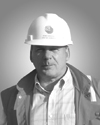...contracts for construction, including the cofferdam, intake, penstocks, powerhouse and tailrace. The contractor, composed of Neilson Excavation Inc., Saint-Nicolas, Québec, and Entreprises Bon-Conseil, L’Ancienne-Lorette, Québec, is working on most of the sites on the ESR project. The total construction value of Eastmain-1-A, including capital equipment, is $856 million.
Eastmain-1 served as a training ground for the construction trades now working on EM-1-A, says Virgile Albert, project administrator for the Rupert Diversion. But the earlier project also set a benchmark for EM-1-A to beat, says Denis Groleau, Eastmain site manager. He wanted to work faster and easier than on EM-1, and he saw a way to do that by covering the powerhouse faster, with precast concrete panels.
Rather than erect the steel framing on the main floor level, the design starts the steel on the Phase 1 concrete, well below it. A shop in the Lac Saint-Jean area, 700 km away, and another in Montreal, 1,000 km away, are fabricating and delivering the panels to the site by truck. The structural steel now is largely complete, and the building is being enclosed to allow work to continue, sheltered from the winter weather not far off. Inside the powerhouse, the 780-tonne overhead crane is being installed, and mechanical and electrical work is in progress. Concreting of the intake structure also is in progress, while work is continuing on the three 127-m-long, 8.8-m-dia penstocks and draft tubes.
Sarcelle
The Sarcelle Powerhouse is a low-head, run-of-river plant. The design, by the Tecsult Group, Montreal, has made this one of the James Bay project’s technical innovations: the first powerhouse in Hydro-Québec’s system to use bulb turbines, in which the turbine and generator both are housed in the same watertight metal casing.

Site Manager, Innovations will help speed Eastmain-1-A powerhouse.
“We had to sell the bulb turbine to Hydro-Québec Production,” says Gérald Saint-Pierre, an engineer at the Sarcelle project. For an application like Sarcelle’s 12-m head and heavy flow, it is a good choice, he says. The competing choice, a Kaplan turbine, was too expensive. It requires a bigger plant, with more excavation and concrete than a bulb turbine, he notes. The powerhouse will have three 50-MW units, made by Alstom Hydro Canada, Sorel-Tracy, Québec. At more than 7 m dia., they will be the largest bulb turbines in the world, say Hydro-Québec officials.
EBC-Neilson excavated the Sarcelle site from September 2008 until early June of this year, except for the winter shutdown from December to March. To achieve the required dimensions of 40 m deep by 60 m wide and about 250 m long, work proceeded seven days a week in two 10-hour shifts, says Saint-Pierre.
CRT-Hamel, a joint venture of Lévis, Québec-based CRT Construction Inc. and St-Édouard, Québec-based Hamel Construction Inc., last February won the contract for concrete work on the powerhouse, water intake and related work. The concrete is batched at the site by twin Liebherr “retractable” plants. Delivered by 10 truck convoys to the job site, they were assembled in only six days. After a crane lifted the plants from the center, the external walls were fitted into place, conveyors and outlet tanks were installed, and the plants were in business.
Only one plant operates at a time, batching 79 cu m per hour, while the other stands backup, says Saint-Pierre. The work is on schedule for completion by the end of 2010.
The Sarcelle reservoir will rise rapidly when the Rupert River diversion begins in November, so the upstream cofferdam had to be built up to accommodate the rise. “After the project was approved, we decided to delay...


Post a comment to this article
Report Abusive Comment